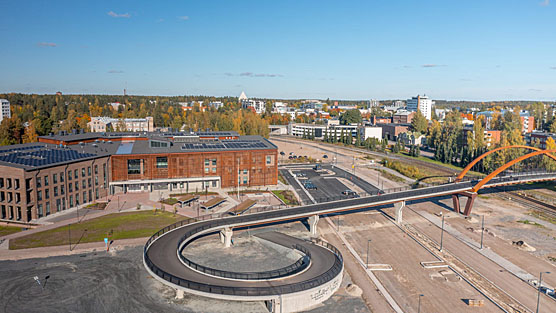
Kipinä House and Vanhankirkonsilta © The City of Hyvinkää 2021
The design of Hyvinkää's Hangonsilta residential area was based on supporting and promoting sustainable mobility. The planning of the area took particular account of walking and cycling opportunities, as well as the accessibility of green areas. The Hangonsilta area is involved in the “Towards Carbon Neutral Municipalities and Regions” (Canemure) project.
The Hangonsilta area is built near Hyvinkää railway station, right next to the track. The area will offer a place to live for about 2,000 people.
“The location of the area in the old railway yard area supports sustainability, as there is no need to introduce new undeveloped areas. This enables building densely and the distances to the centre’s services are short. The location is also very important in that the area supports sustainable mobility,” says Kimmo Kiuru, traffic engineer from the City of Hyvinkää.
Walking and cycling routes connect Hangonsilta to the city
The Vanhankirkonsilta bridge for walking and cycling was built between the city centre and the Hangonsilta, which crosses the track. The bridge and the walking and cycling route across the area also serve as a connection to the valuable outdoor and nature areas of Sveitsi and the Konecranes factory area. The Kipinä House, which was completed in 2021 and is home to Hyvinkää Upper Secondary School and Hyvinkää College, is located right next to the bridge.
“The location of the area makes it easy to create walking and cycling connections that also serve the surrounding area,” says Anitta Ojanen, head of zoning at Hyvinkää. “The Vanhankirkonsilta bridge is an essential part of the area, as it allows travel to the city centre and shortens walking and cycling distances. The bridge has been built near the Kipinä House and it has also been designed as a landmark that fits in with the milieu of the old railway yard area.”
The Hangonsilta residential area used a green factor tailored to Hyvinkää, which was used to ensure the adequacy of the green areas in the planning of the area's blocks. “The first part of the area was built quite densely and in the planning of the second phase we will expand the area and place the parking spaces on the edges of the area. This leaves more green spaces in the middle of the blocks,” says Ojanen.
Covered parking areas that are safe for cyclists
The Hangonsilta residential area is Hyvinkää's first zoning area to include a requirement for the number of covered bicycle spaces. The Kipinä House also has plenty of safe storage places for bicycles and correspondingly less parking area.
One parking space per 120 square metres of floor area was planned for the residential area. However, this number proved challenging as many small homes were planned in the area, which increased the need for parking spaces.
For electric traffic, there is a requirement for charging points for electric cars in the parking area of the Kipinä House. The aim is also to bring a shared car park to the new part to be built for the use of the whole area.
Residents involved in planning
The development of walking and cycling in the Hangonsilta area is actively monitored. A counter has already been installed at the end of the Vanhankirkonsilta bridge, which continuously measures the number of pedestrians and cyclists. Traffic forecasts estimate that the number of users would be around 1600 per day, of which around 600 would be pedestrians and around 1,000 would be cyclists.
The residents' views on the area have been surveyed in a thesis with the help of a questionnaire. The survey showed that residents want more urban structures that support sustainable mobility, but they do not want to give up their own car, even if it is not used every day.
“It takes time for people to embrace new mobility opportunities. Hyvinkää's urban structure as a whole does not support walking and cycling, as one's own car is used a lot when moving to the city's rural outskirts. This also depends in part on attitudes – most of the residents live near the city centre,” says Kiuru.
The students of Hyvinkää Upper Secondary School have also been involved in the planning of the area. A workshop on sustainable mobility was organised with upper secondary school students as part of the Finnish Meteorological Institute and Hyvinkää’s Canemure subprojects. Renewable energy, the diversity of green spaces, functional local services, the sharing economy and functional cycling networks were highlighted in the wishes of the upper secondary school students.
Partnership zoning made sustainable solutions possible
The Hangonsilta area was planned through partnership zoning. This means that from the outset, all the implementers of the area – the city, as well as other developers and construction companies – are involved. In this way, implementation planning can already be done at the same stage as zoning.
“Partnership zoning provides an excellent opportunity to bring sustainability issues, such as the number of bicycle spaces, into the planning process. Together with our partners, we were able to create a high-quality residential area where sustainable mobility is possible,” says Ojanen. “Partnership zoning, of course, also requires good cooperation and management within the city.”
Learn more
Further information
- traffic engineer Kimmo Kiuru, City of Hyvinkää, firstname.lastname@hyvinkaa.fi
- head of zoning Anitta Ojanen, City of Hyvinkää, firstname.lastname@hyvinkaa.fi